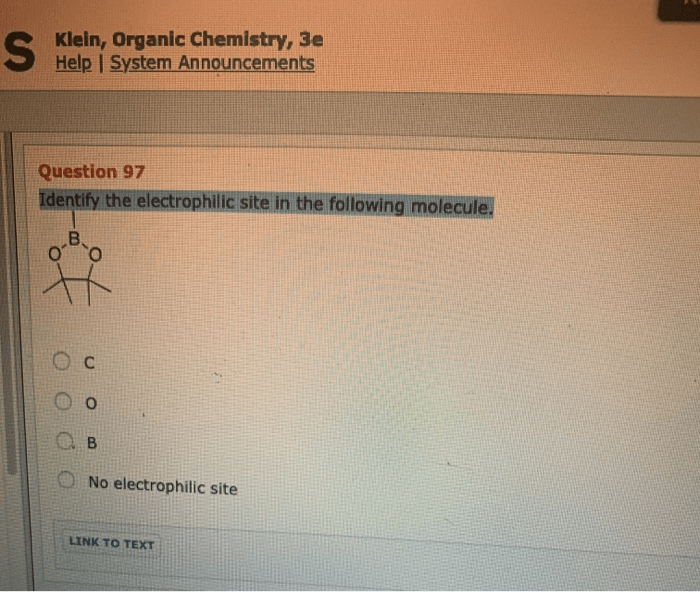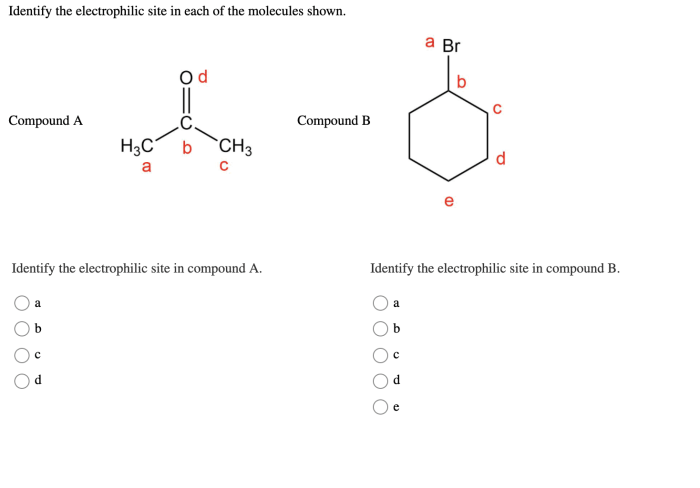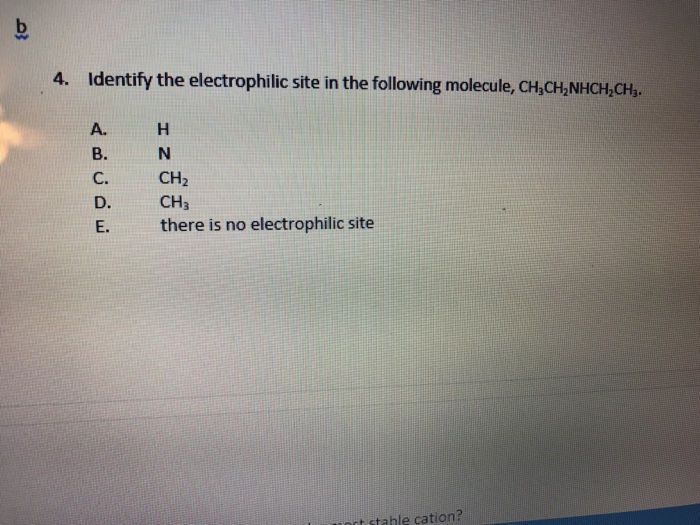Identify the electrophilic site in the following molecule. – Embarking on an exploration of electrophilic site identification, this discourse delves into the fundamental concepts, influential factors, and practical applications of this crucial aspect in organic chemistry. By understanding the electrophilic nature of molecules, we unlock the key to comprehending their reactivity and harnessing their potential in various fields.
Electrophilic sites serve as magnets for electron-rich species, initiating a cascade of chemical reactions that shape the molecular landscape. Delving into the intricacies of electrophilicity, we uncover the factors that govern its strength, enabling us to predict and manipulate the reactivity of organic compounds.
Identifying the Electrophilic Site: Identify The Electrophilic Site In The Following Molecule.

In organic chemistry, an electrophilic site is a region within a molecule that is susceptible to attack by an electron-rich species, known as a nucleophile. Electrophilic sites are crucial for understanding and predicting the reactivity of organic molecules.
Several factors influence the electrophilicity of a site, including the electronegativity of the atom bearing the positive charge, the resonance effects of neighboring groups, and the inductive effects of substituents.
To identify the electrophilic site in a given molecule, consider the following steps:
- Identify atoms with a positive charge or a partial positive charge.
- Consider the electronegativity of the atoms surrounding the positively charged atom. More electronegative atoms withdraw electron density, making the adjacent atom more electrophilic.
- Examine the resonance structures of the molecule. Resonance can stabilize positive charges, making the site less electrophilic.
- Analyze the inductive effects of substituents. Electron-withdrawing groups increase the electrophilicity of a site, while electron-donating groups decrease it.
Examples of Electrophilic Sites, Identify the electrophilic site in the following molecule.
Common functional groups that contain electrophilic sites include:
- Carbonyl groups (C=O)
- Iminium ions (R 2N +=CR)
- Alkynes (R-C≡C-R)
- Alkenes (R-CH=CH-R)
- Aromatic rings
Specific examples of molecules with electrophilic sites include:
| Molecule | Electrophilic Site |
|---|---|
| Acetaldehyde | Carbonyl carbon |
| Imine | Iminium carbon |
| Ethylene | Alkene carbon |
| Benzene | Aromatic ring carbon |
Applications of Electrophilic Site Identification
Identifying electrophilic sites is crucial in chemical reactions because it allows chemists to predict the regioselectivity and stereoselectivity of reactions.
In drug design, electrophilic site identification helps identify potential targets for drug molecules. By targeting electrophilic sites on enzymes or receptors, drugs can inhibit their function and treat diseases.
Other applications include:
- Polymerization reactions
- Catalysis
- Organic synthesis
Advanced Concepts
The electrophilicity of a site is closely related to its molecular orbitals. Electrophilic sites typically have low-lying LUMOs (lowest unoccupied molecular orbitals), which makes them more susceptible to attack by nucleophiles.
Computational methods, such as density functional theory (DFT), can be used to predict the electrophilicity of sites. These methods provide insights into the electronic structure of molecules and can help identify potential electrophilic sites.
For further exploration of electrophilic sites, refer to the following resources:
FAQ Summary
What are electrophilic sites?
Electrophilic sites are regions within organic molecules that possess an affinity for electron-rich species, making them susceptible to attack by nucleophiles.
How can I identify electrophilic sites in a molecule?
Electrophilic sites can be identified by considering factors such as electronegativity, hybridization, and the presence of electron-withdrawing groups.
What are some common functional groups that contain electrophilic sites?
Common functional groups with electrophilic sites include carbocations, aldehydes, ketones, and acid chlorides.



